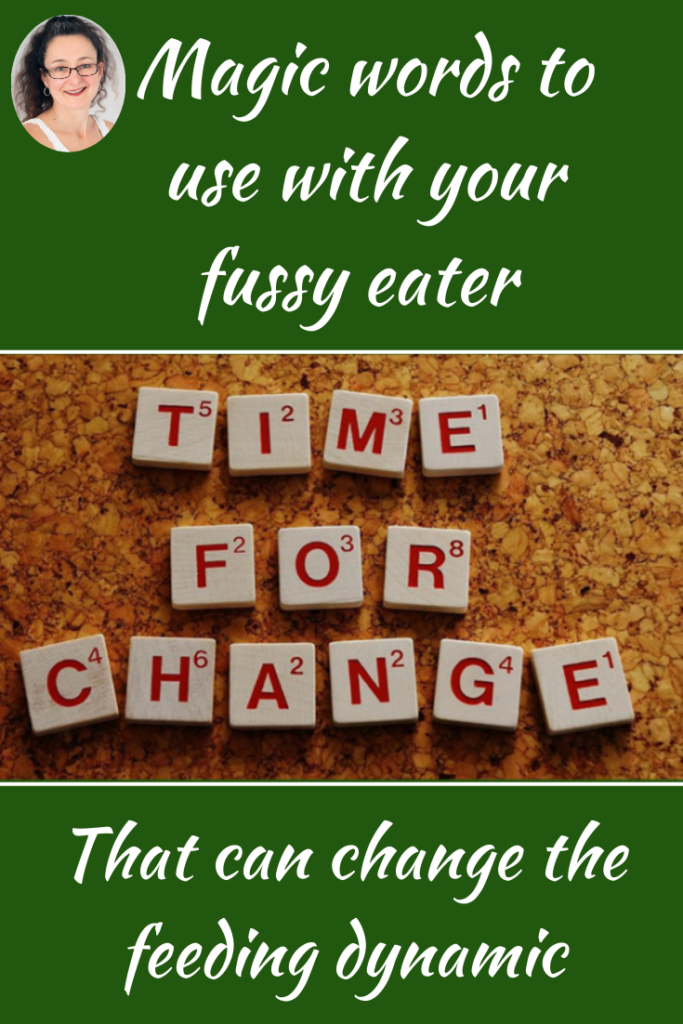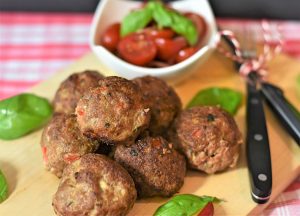
Magic words to use with your fussy eater
The words you say are powerful.
Watch your child’s face light up when you say something complimentary, or them hang their head when you are disappointed.
If you have a fussy eater picking the right words around food can be very important.
But it can seem like nothing you say is the ‘right’ thing. Either your child is anxious or upset or you feel like you’re giving in and doing the ‘wrong’ thing but making them happy.
I’ve compiled a list of words that can be a great addition to the vocabulary and can make a big difference around food and feeding. They can change the dynamic at meals and even encourage a child to be more receptive to new foods.
Magic words to use with a fussy eater
1. “Yet” – this is one of my favourite words! Often when you have a fussy eater both of you have closed off the possibility of them eating a new food.
Your child looks at a new food and says, “I don’t like it”.
This stops all future progress.
Instead, I would rephrase this as “this is not my favourite thing yet”, opening their mind to the possibility that later they may be able to eat it.
Small switches in language can be very important.
2. “I like this because” – it’s very tempting to tell your child they will like something – especially when you KNOW they will.
But instead of putting that spotlight and possibly pressure on them, you can take the emphasis away by talking about someone else, like yourself.

You are still putting across the same message, but without the focus being on them.
3. “This is just like” – knowing what will happen when something goes in the mouth can be very comforting for an anxious (or stubborn) eater. You can do this by relating it to a food that a child is already able to eat comfortably, for example:
“This is crunchy like those crackers you like, but a little bit sweet like your strawberry yoghurt”. Doing this gives your child a positive way to think about a new food and contextualizes it for them.
4. “Which would you prefer?” – When you offer choices, it gives your child some autonomy over decisions. Giving them the option of two choices (more can be overwhelming) lets them know that you value their opinion and that they have some control.
“Would you like the crackers or the pretzels?”, or “did you want the cheese grated or in slices?”

5. “You don’t have to eat it” – building comfort around foods is one of the critical factors in supporting a picky eater to eat more variety. In order to do this, it’s important they become comfortable with the look, the feel and the smell.
None of this can happen unless a child is able to get up close and personal with a food. However, if foods are there with the expectation that they must take a bite, then it can often stop this valuable process.
Having the broccoli on the plate is an important part of the learning process. But, if your child knows that having it on the plate leads to pressure to eat it, they are less likely to want it on the plate.
If the broccoli is allowed to stay on the plate, with no pressure to eat it, the learning can happen!
6. “This is what’s available” – (which includes food you enjoy). Children who are uncomfortable around food often make demands about what they want to eat. This is super logical. If you are not comfortable around food, then making sure it’s a favourite is important.
However, if your child does only get served peanut butter sandwiches, fairly soon it can become the only thing they will accept to eat.

Instead, you can explain that what is on the table is what the family is having for the meal. You can also point out that there are foods that they are able to eat too.
Serving those options they can enjoy is important, but it does not always have to be a ‘favourite’. And they may demand a peanut butter sandwich when they are perfectly capable of managing some pasta – which seems behavioural -and therefore can be treated as such.
7. “It’s okay if you’re not hungry, but please stay to chat” – many picky eaters, especially younger ones want to eat and dash, or eat two bites and whoosh, or even not eat anything and prefer to play instead of eat (which is all logical!).
However, not staying at the table may prevent a child from eating enough. Research backs this up.
It’s important to have the opportunity to sit still and contemplate the food. Allowing them to do this without pressure to eat may help them to independently eat more.
Even if this is not the case the first, second or even tenth time, it is something that is important long-term for supporting them to eat more volume and to eat more widely. When your child is at the table, they can watch you modelling how to eat widely and well and do it pleasurably.
8. “You can take it out of your mouth politely” – it’s important that your child can taste a food and if it’s really unpleasant be able to take it back out of the mouth again. Sometimes you do put something in your mouth that tastes or feels awful.
Having permission to spit it nicely into a napkin or the hand is positive and may pave the way for more confidently trying other foods.
9. “What do you think?” – rather than asking the loaded question “do you like it?”, reframing as “what do you think?” enables a child to form their own opinion about a food.
It also takes it from a binary “yes I like it” or “no, I don’t like it”, to a more open-ended “I think …”. You can learn a lot from the things that your child explains about a food too, if you’re open to listening.
Asking this question also gives your child the opportunity to think about the food more objectively, rather than giving the automatic “no I don’t like it”.
You can follow this up with words like “what could improve this for you?”, or “I wonder what it would be like if we…”.
10. “You’re still learning” – it’s very important that your child realizes that learning to eat is a process. There will be some things that are easy, and other things that are more challenging, and that’s the same for everyone.

Knowing it’s a process rather than something that needs to be aced right now and EVERY time something goes in the mouth is important. It also means that the cucumber that was tried and wasn’t great, may need to be tasted over and over before it does become a favourite.
You can use some positive phrases to let your child know that you know they have done something challenging for them like “you tasted it even though you weren’t sure”.
Using words and phrases that prevent anxiety or upset at the table is critical. The more relaxed we are, the more likely we are to eat.
Are any of these words or phrases you use? Do you have suggestions for other helpful ones?
Judith, MA Cantab (Cambridge University), MSc Psychology (first-class honours), is working on a PhD, an AOTA accredited picky eating advisor and internationally certified nutritional therapist. She works with 100+ families every year resolving fussy eating and returning pleasure and joy to the meal table.
She is also mum to two boys and the author of Creating Confident Eaters and Winner Winner I Eat Dinner. Her dream is that every child can approach food from a place of safety and joy, not fear.
Learn more about Judith here: https://theconfidenteater.com/about/
